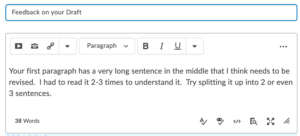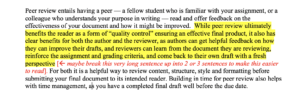APPENDICES: Academic Writing Basics
Appendix H: Peer Review Essentials
Suzan Last and Loren Gaudet
Peer review is standard in both professional and academic contexts. When you submit a paper in a course, or deliver a document to a client, you’re not usually sitting in front of the person who reads your work while they read it. Even though your writing may make sense to you, there’s no guarantee that your reader will engage with your writing in the way that you intended. In fact, different readers will have different lived experiences, different knowledges, and different backgrounds, and all of these can affect a reading experience. This is one of the reasons that it’s so important to keep your audience(s) in mind while you’re writing. If you are creating content, whether written or in some other mode, having a colleague review it before presenting it to the final intended audience is common practice.
Peer review entails having a peer — a fellow student who is familiar with your assignment, or a colleague who understands your purpose — review and offer feedback on the effectiveness of your content and how it might be improved. While peer review ultimately benefits the intended reader/user as a form of “quality control” ensuring an effective final product, it also has clear benefits for both the content creator and the reviewer. In the process of peer review, creators can get helpful feedback on how they can improve their content/organization/format, and reviewers can learn from the content they are reviewing, reinforce the assignment and grading criteria, and come back to their own draft with a fresh perspective. For both it is a helpful way to review content, structure, style and formatting before submitting your final document to its intended reader. Building in time for peer review also helps with time management, as you have a completed final draft well before the due date.
In order to attain the maximum benefits of Peer Review, both authors and reviewers should keep the following strategies in mind:
Author Strategies
- Be prepared: submit the most polished and complete draft possible in order to fully benefit from peer review. A partial or very rough draft can benefit from some preliminary review, but a completed draft can elicit more helpful and detailed feedback.
- Give reviewer some guidance: describe the concerns you have about your paper at this point. Alert your reviewer to areas where you would particularly appreciate feedback. If the reviewer is not familiar with your purpose and audience, fill them in.
- Be open to new ideas: avoid becoming defensive about the feedback; remember, your reviewer is trying help you improve your draft. Consider alternative viewpoints you may not have thought of before; listen before deciding what you will do.
- Consider advice carefully: think critically about whether the reviewer’s suggestions will help you to improve your draft and if they are appropriate for your purpose and audience. What and how you revise is ultimately up to you; take your reviewer’s advice with a grain of salt, and seek additional advice if you are unsure what to do.
Reviewer Strategies
- Know the document’s purpose: review the assignment description and/or grading rubric before reviewing the draft; know what the document is trying to achieve before you assess whether it needs revision to achieve it.
- Focus on the positive: be honest and critical, but also point out strong areas where things are working well. Use positive, constructive tone to discuss areas that could use improvement. Don’t gush (“your paper is so awesome!”) and don’t trash (“This totally sucks! Rewrite the whole thing!”). Remember your purpose is to help the author find ways to improve the draft; recognize what is already good, and suggest what could use further work.
- Be specific: explain why a sentence, paragraph, or image needs improvement; explain why you as the reader are confused or bothered by a specific phrase or passage, or why the logic does not flow for you (be “reader centred”).
- Be courteous: be aware of your language use and tone when addressing peers. Avoid patronizing or “talking down” to your peers when giving advice.
- Don’t edit: Your job is reviewer, not editor. Don’t fix errors or phrasing issues; just point out areas that need improvement. You might offer ONE sample correction to demonstrate what you mean, but do not engage in wholesale editing. A key purpose of peer review is for each person to learn how to edit their own work based on reviewer feedback.
- Be efficient: don’t overwhelm your author with too much detailed feedback. A page that has more feedback notes than content will be very difficult to process. Focus on a handful (3-6?) of the most important revisions that are needed to help improve the draft. For example, if there are numerous spelling errors, don’t point them all out; highlight one or two and then comment that the draft contains numerous spelling errors that will need fixing before it can be submitted.
Methods of giving feedback
There are many ways to provide feedback on someone’s work; how you do this will depend on what form of work you are reviewing, the context, and the situation. For example, if you are doing a peer review in a classroom with your peer groups face-to-face, you might give feedback verbally, or you might put hand-written feedback on their papers. In some cases, your instructor might give you a checklist to use, which you must fill out as you are reading your peer’s draft.
If working remotely, you might read your peer’s work as an online post, and post a reply in which you write out all your feedback within the reply window, like the one below.

To offer more detailed feedback, you might download the author’s document and write inline comments on the draft – ideally using a different colour to make your comments standout more easily, as seen below.

Then upload your revised document as a reply to the author.
Inline comments can affect the formatting of the document, so you may instead want to use the “insert comment” function.
 This will allow the document formatting to remain stable, and your comments can be easily deleted after reading.
This will allow the document formatting to remain stable, and your comments can be easily deleted after reading.
Read Aloud is a method of peer-review that focuses on giving the content creator access to the reader’s experience. Rather than having a peer offer written feedback about the draft, the Read Aloud method invites students to express their experience as a reader. When a peer reviews your work, you can see how they are responding to your draft in real time. When you’re reviewing a peer’s work, you get practice expressing your experience as a reader and thinking critically about why and how different aspects of writing can shape your reading experience. These reflections are really helpful if you can apply them to your own work!
Although there are many different ways of doing read aloud peer review, there are some guidelines to follow. Consider working in pairs, taking turns reading each other’s drafts out loud. If you’re reading your partner’s work out loud, here are some guidelines that might be helpful:
- If you’re face-to-face, try to read your partner’s draft loud enough so that they can hear their writing being read out loud. Sometimes, a change from reading to hearing can help to catch writing habits that need attention.
- Try to make yourself comment on your experience after each sentence!
- If you stumble, pause, or have to reread something, this is usually a good opportunity to reflect on why this happened and explain this to your partner.
- Remember to be kind, supportive, and compassionate.
If your draft is being read out loud, here are some guidelines:
- Make sure to have a draft of your writing on which you’re able to make comments, and a way of sharing your draft with a partner. This could mean having 2 printed copies of your draft, using an online tool such as google docs, or simply having a laptop or tablet that you feel comfortable handing to your partner.
- While your partner is reading your work out loud, listen carefully. Sometimes, changing the medium of your words can help you to catch writing habits that need attention.
- Take notes on your reader’s reactions. Are there places where what you’re trying to say and what they’re responding don’t match up? If so, highlight these places and return to them for revision.
- If your partner says, “I like this,” consider asking them to be explicit about their reading experience. What about it do they like?
- If you have specific concerns about your writing, consider highlighting these for your partner. For example, you might ask your peer to focus on your argument or your evidence.
Having your work read out loud can be uncomfortable, nerve-wracking, or even scary! Having said that, having the feedback put in terms of your reader’s experience can help. Practice and repetition can also help to make this less intimidating.
In order to make sure that you and your partner are commenting on the experience of reading — and NOT making corrections to the paper — the table below offers some guidelines for things to say.
| Instead of saying…. | Try saying… |
| This paper has no thesis | I’m through the first paragraph, and I’m still not quite sure what the main claim of the paper is. |
| This word is wrong | I find this word choice to be confusing. It means something different to me. |
| This is a run-on sentence or This sentence is too long | I’ve lost track of what’s happening in this sentence. |
| This is unclear | I’m having trouble understanding this part. |
| This point doesn’t belong here | I’m struggling to see how this point relates to your argument. |
| This is really good | I found this sentence easy to read because… |
Whichever method you use to provide feedback, keep in mind these essential guidelines:
- Be specific: give the author specific examples and details; avoid vague or overly general statements
- Be constructive: try to help the author improve the quality of their work in substantial ways; point out what is working well
- Be courteous: remember the golden rule, and give feedback in a way that you would like to receive it yourself.

